No one is better at building anticipation ahead of a launch than Apple. New product launches trigger publicized spec leaks and reveal events draw crowds in the millions (over 2.7 million people watched the iPhone 12 presentation live).
In the iPhone 13’s first quarter, it generated $71.6 billion in revenue (despite parts shortages and a global pandemic).
You don’t have to create Apple-level hype to see a successful new product launch. Trading app Robinhood launched with almost one million users thanks to a pinpointed market need and waitlist pre-launch campaign.
Unfortunately, many product launches take a “build it and they will come approach,” failing to gain traction and eventually fizzling out. These launches lack the key component of promotion and acquisition.
In this article, you’ll learn how to design an effective new product launch plan to avoid this pitfall and generate demand.
Before starting on your new product launch plan, make sure you’ve crafted a product launch strategy. This’ll help you inform and execute the tactical aspects of your product launch plan.
Pre-launch: Paving the way for a successful product launch
The pre-launch stage is often the busiest and most impactful stage of a new product launch. Rushed or poorly planned product launches will flop.
Activities during this phase focus on building brand awareness and anticipation, developing product messaging, identifying key marketing channels, and driving demand for your new product to ensure a successful launch.
1. Challenge yourself to become a product expert
Some marketers stop learning about their product after the initial research and strategy development. In reality, you’ll be learning and adapting your product and strategy as you gain more insights from your customers.
Through the entire product lifecycle, the product marketing manager (PMM) and their team should be the masters of the new product. Using the product marketing strategy you’ve developed, your product marketing team must know:
- What the product does;
- Why it exists;
- Who it serves;
- How it helps them, and;
- Why it’s the best option.
You’ll continually develop this expertise by working closely with other departments. Learn from marketing, sales, and customer success what customers are raving and ranting about.
Interview product managers and engineers to gain a technical understanding of the product. Or better yet, use the product yourself. Tie challenges back to your product benefits.
Slite, a digital workplace for async teams, connects their customers’ challenges to their product benefits on their ”Discussions” feature landing page.

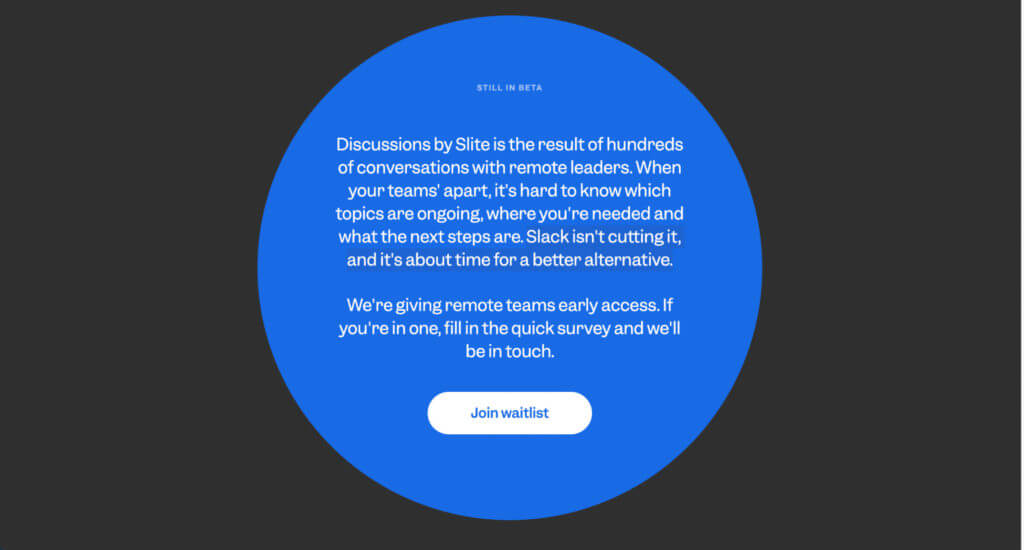
Slite found that a common frustration around a competitor’s tool is communication getting lost in Slack threads.
Instead of dancing around the topic, they called it out on the landing page:
- “A place for more focused discussions.”
- “Tired of endless Slack threads?”
- “Slack isn’t cutting it, and it’s about time for a better alternative.”
Learn all you can from market research and by interacting with other teams. Then tie your customers’ challenges to benefits in the clearest way possible.
2. Generate excitement and buy-in with an internal press release
Create an internal press release to communicate your positioning with your entire team.
Having a single source of truth document ensures clarity and consistency across marketing, sales, product, and customer success teams. It also builds internal excitement for the new product launch.
Amazon’s former director, Ian McAllister, describes a framework he uses for internal press releases:
“Heading: Name the product in a way the reader (i.e. your target customers) will understand.
Subheading: Describe who the market for the product is and what benefit they get. One sentence only underneath the title.
Summary: Give a summary of the product and the benefit. Assume the reader will not read anything else so make this paragraph good.
Problem: Describe the problem your product solves.
Solution: Describe how your product elegantly solves the problem.
Quote from You: A quote from a spokesperson in your company.
How to Get Started: Describe how easy it is to get started.
Customer Quote: Provide a quote from a hypothetical customer that describes how they experienced the benefit.
Closing and Call to Action: Wrap it up and give pointers where the reader should go next.”
Keep it short and simple (under a page and a half), and avoid overly corporate or technical language. McAllister revealed his trick for communicating the product’s unique positioning and messaging is to pretend you’re talking to Oprah:
“Imagine you’re sitting on Oprah’s couch and have just explained the product to her, and then you listen as she explains it to her audience.’”
The press release should help shape every aspect of product development. The product team can refer back to the document, asking at all times if what they’re developing meets the brief.
Doing so will keep the product team focused on customer benefits and help them avoid wasting resources on features that aren’t important.
3. Building genuinely useful marketing personas
Often, marketing personas are empty, unrealistic imitations of who marketers hope their customers are. This happens when the persona development process is top-down instead of bottom-up.
Rand Fishkin, founder and CEO of SparkToro explains his experience with the typical user persona:
“Build personas → Make sure they get used across the company → Create product and marketing initiatives to employ the personas → Get no benefit at all → Doh!”

Fishkin recommends a five-step approach to creating genuinely useful buyer personas:
- List out the applications your personas are solving for. Who’s doing what with your product? What information might they require to do that work effectively?
- Audit and cull. Identify realistic elements that can be tested and proved through data-gathering exercises.
- Substantiate with data. Leverage internal customer data from social accounts, web analytics, email subscribers, and current product usage data. Scrape insights from market research, industry statistics, and competitor press releases.
Interview your customers, your prospects, and your lost deals to understand real-life needs and challenges. Access audience intelligence from tools like SparkToro, Brandwatch, and Helixa to gather quantitative data at scale.
- Segment your personas. Use the data you’ve gathered to establish the characteristics that separate one group from another. If two or more sets of your market share overlapping behaviors and characters, group them under one persona.
- Settle on a presentation format. Present your personas in a way that makes sense for your team to digest. That might be a Google Doc with a few bullet points, an infographic-style design, or a short video.
HubSpot offers a free tool that creates personas like this:
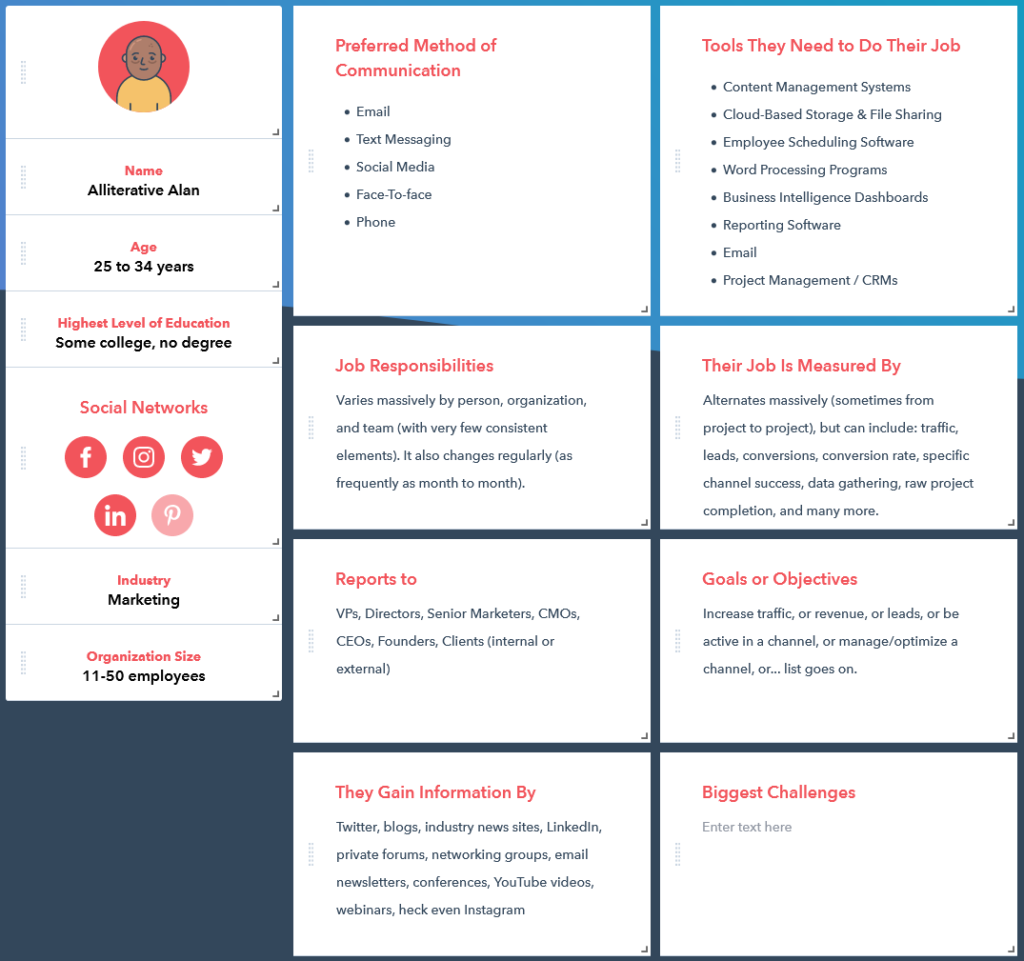
4. Determine which channels you’ll capitalize on
Your product marketing strategy should inform the channels you’ll use to reach your audience (leading up to and including launch day).
Build a list of the specific channels you’re going to use. Then consider:
- What you’re going to share in which locations;
- When you’re going to share it;
- Who is responsible for executing and monitoring each task.
Here are four common channels to build hype and reach before you launch and on launch day.
Paid Media
Consider which channels you’ll allocate ad spend. Your next steps will depend on the channels you use.
For example, will you run Google Ads? You’ll need to determine the key search phrases you’ll target.
Considering a publisher network? You’ll need to identify where your audience is most engaged and ensure your budget is going to the right places.
No matter your chosen channel, ensure messaging and creative tie back to your product marketing strategy.
Organic
Customers who want your new product may come to you through various organic channels, like search and social media.
If you want to encourage organic traffic by investing in content marketing, you’ll need to identify the topics most relevant to your new product users.
You’ll also want to consider how your website needs to change to reflect the new product. Will you need to create a new landing page, feature the product on your homepage, create new content on your blog, etc.?
Take Later, an Instagram marketing platform.
When it dropped a new product feature (first comment scheduling), Later knew it could reach its existing audience on Instagram.
The platform designed an informative video to demonstrate exactly how the new product works, and published it on Instagram where their target users are.
Digital PR
If you have existing relationships with media (newspapers, magazines, radio, online publications), use them to broadcast your launch.
If not, where do opportunities exist to form new relationships?
Develop a strategy for media outreach. Develop easy-access content that journalists, PR, and other media professionals can use (e.g., press releases and brand kits).
Take Happsy, an organic mattress retailer.
When launching its new product, Happsy leveraged PRNewswire’s large reach to promote a press release announcing its certified organic bed-in-a-box.
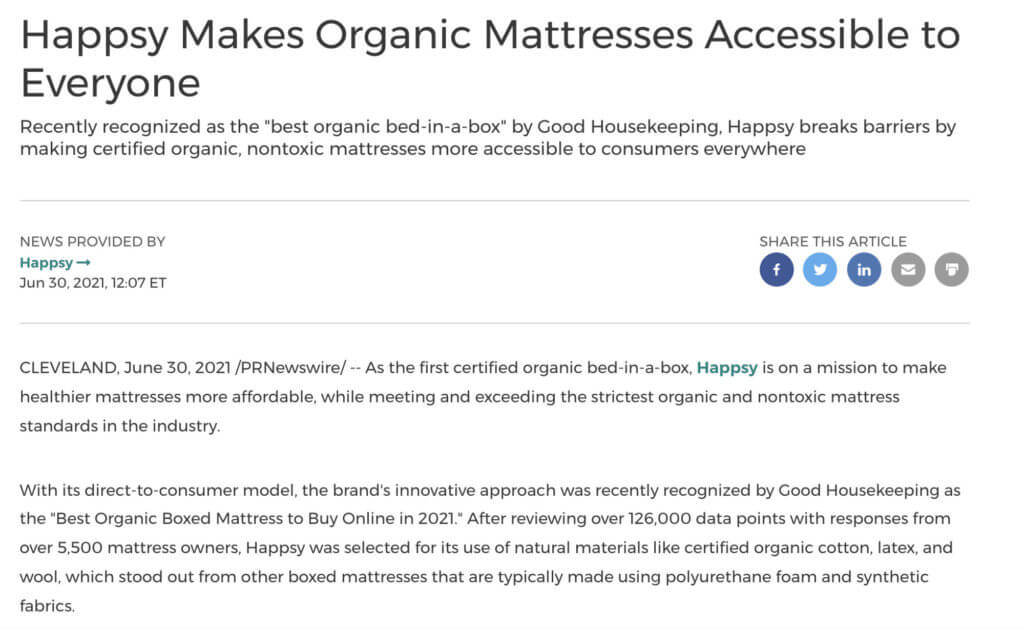
Take advantage of relevant media outlets and include an exclusive offer to entice readers:

Traditional press releases can only take you so far. Happsy leveraged media outlets they had relationships with and issued a press release.
To make a real splash, you have to be where your audience is most active and give them content they’re looking for.
For example, AI video editing software Kamua launched on Product Hunt, where tech-minded individuals learn about new tools.

Their launch campaign on a site targeting their user base gained them so much engagement, they rose to the third “most hunted” product on the site in a day.
Leverage digital PR by showing up where your audience is active and engaging with them on launch day.
Influencers
Think about how you’ll leverage third parties, like thought leaders and other brands, to promote your product and spread your message.
Mention is a platform where you can find influencers and track their activity once employed to see how it’s impacting your reach.
Consequently, Mention put this to good use when marketing its new product. It created an influencer marketing microsite and got other marketing influencers involved to help capture more attention.
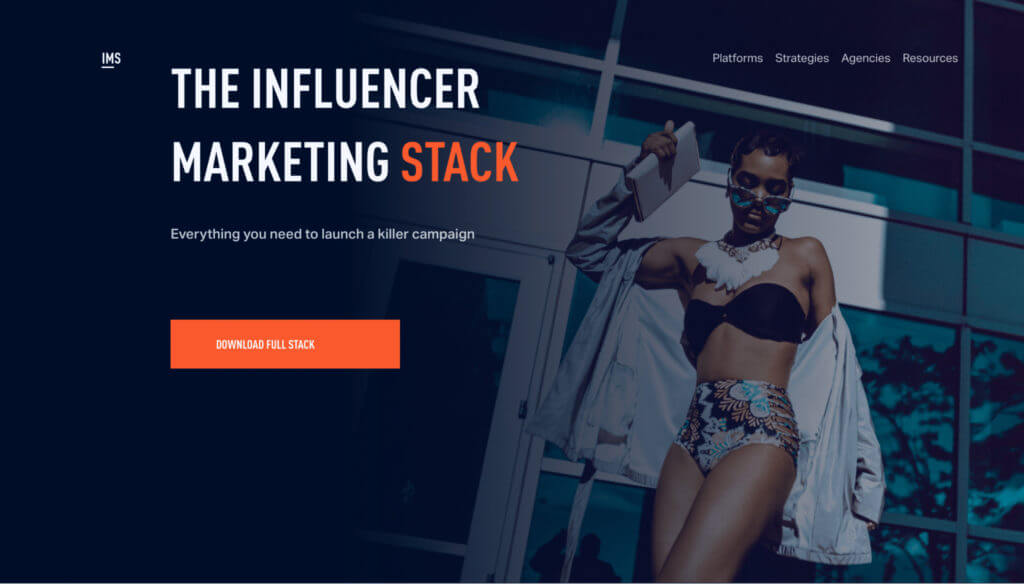
There are many ways to use influencer marketing. Consider:
- Whether you’ll use a partner channel;
- Whether you’re involved in any communities that you might engage;
- If you can leverage online forums like Reddit to maximize reach and conversation;
- Whether you’ll use more formal influencer relationships to promote the new product launch.
Millennials don’t want to be advertised to, which is why many businesses are using influencers instead. Learn your audience’s preferences, then fit your channels to your audience.
5. Increase organic visibility to boost brand awareness and demand
Search engine optimization (SEO) is a crucial growth driver for B2B product launches.
Because organic content can take time to reap traffic rewards, publish before launch. This allows time for pages to be indexed, spark conversation, and rank.
Create high-value, intent-focused long-form content to attract top-of-funnel prospects, based on both product-driven and problem-driven topics.
Take sales CRM Pipedrive. One of their target markets is real estate agents.
Pipedrive uses concise, informative, search-optimized descriptions to win top positions, like this featured snippet for the keyword “real estate CRM.”
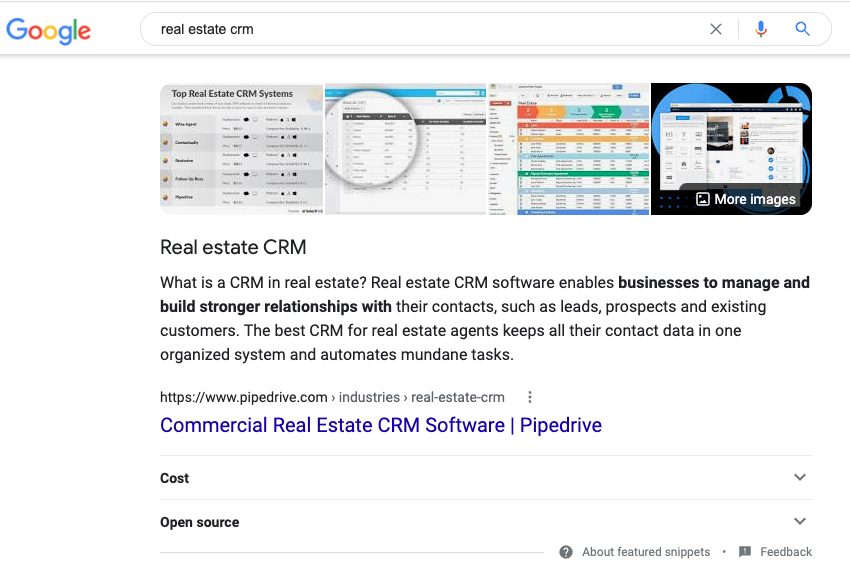
Pipedrive also focuses on developing top-of-funnel, problem-driven content to attract real estate agents struggling with cold-calling and lead generation.
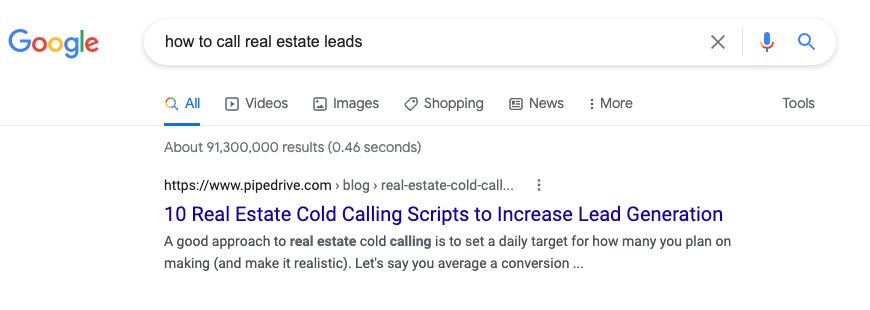
Prioritize topics that have a higher likelihood of ranking.
For example, take these two search phrases “top real estate CRM” and “best CRM for real estate investors.”
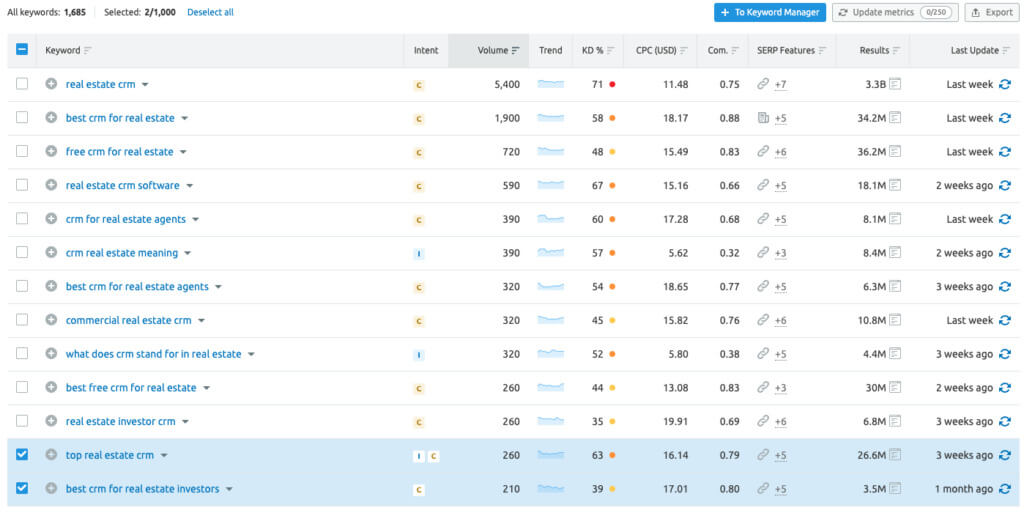
Both keywords have similar monthly search volume, but one has a keyword difficulty of 39% and the other has a difficulty of 63% (according to SEMrush).
Having identified which key search phrases provide the best opportunities, use a tool like Airtable to build out a content calendar, detailing for each piece:
- Topic;
- Headline;
- Keyword;
- Project status;
- Due date;
- Writers and editors responsible;
- Distribution channels.
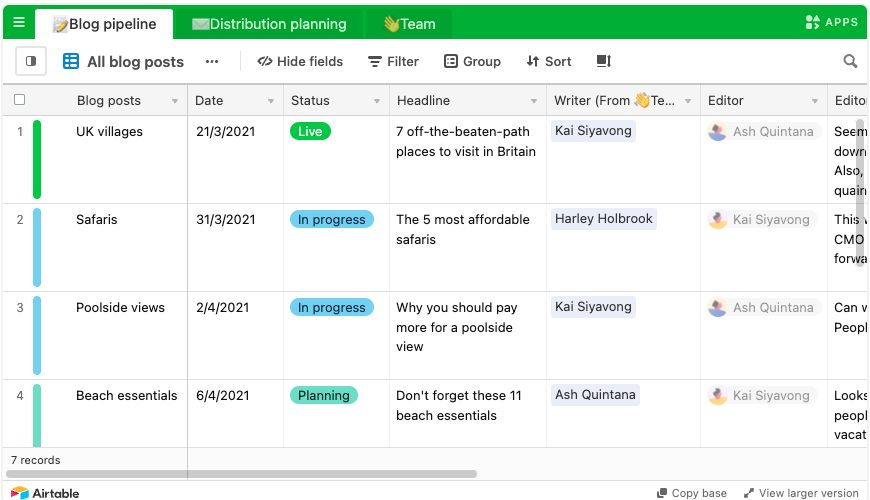
6. Debug website issues and improve user experience
Most of your product launch campaign activities will direct traffic back to your website. So, before launch day, make sure your site is prepared to handle traffic spikes.
OrangeValley found that if their site was just one second slower, their conversion rate dropped by 25%.
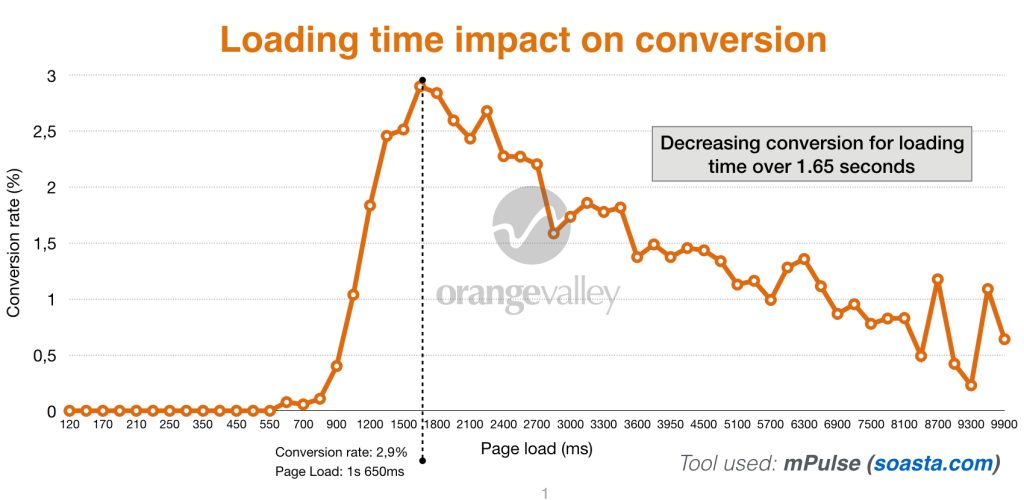
Ensure that your site:
- Has a healthy load speed;
- Is not bogged down by excessive code;
- Doesn’t have any 404 warnings or dead links;
- Is easily navigable;
- Is mobile-responsive;
- Doesn’t host any duplicate content;
- Is secure and uses HTTPS;
- Has an XML sitemap to help search engines crawl and index pages.
Find tools and learn how to fix these issues to prepare your website for traffic and growth in CXL’s article on technical SEO.
7. Collaborate to develop initial messaging
Develop your product messaging in the pre-launch phase, but be prepared to adapt it as you collect customer feedback during and post-launch.
Morgan Molnar, Director of Product Marketing at Momentive, shares a template for developing initial product messaging in her CXL course on product launches.
Use this template to write a short description of your product. Detail key value propositions and the features that deliver them.
Share your product messaging with other teams across marketing, sales, product development, and customer success to gather important feedback.
For example, sales representatives may be able to identify common phrases or language your target audience uses to describe their pain points.
8. Test your message before it gets to your customers
Use message testing products like Wynter to understand how your customers see your product and messaging before bringing the product to market.
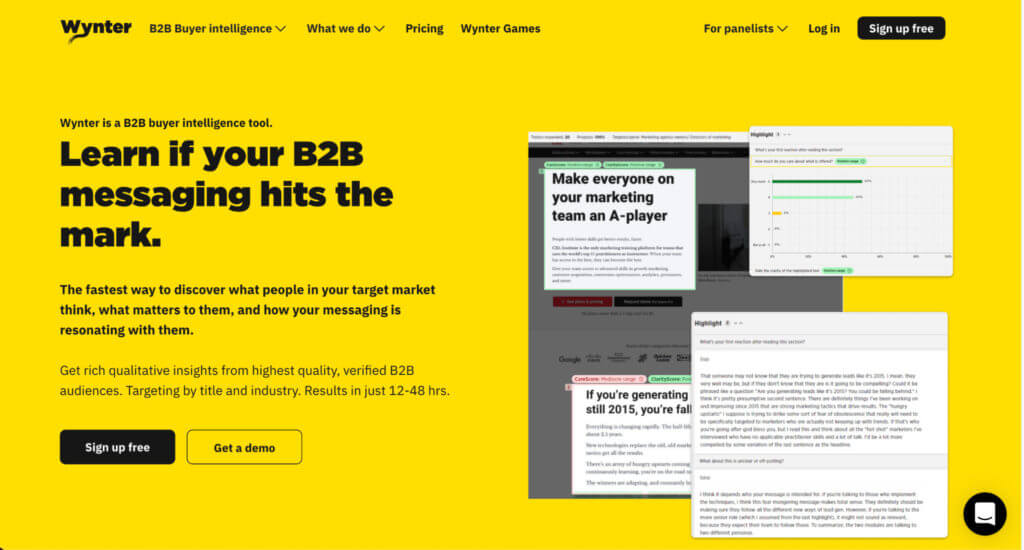
Build your target audience using Wynter’s proprietary B2B panel, set up the test creative (e.g., your new landing page), and customize your test questions.
Use this feedback to amend your product messaging where appropriate, and run a second test to validate changes.
9. Create shareable pre-launch content to generate hype
Prepare for launch day by creating shareable content. This will help generate discussion around your new product.
The more people you have sharing and interacting with your product, the more likely it is to land in front of people who need it and want to buy it.
For example, Rand Fishkin, co-founder at SparkToro, created pre-launch content detailing their funding journey.
Marker.io also launched in public, transparently narrating the entire process along the way. Hotjar describes Marker.io’s launch in their case study:
“Gary Gaspar and his team launched Marker.io, a visual communication tool, back in 2015. Being featured on Product Hunt within a month made them think they had ‘arrived’, but they were far from it: they attracted about 20 upvotes and 2 comments (…one of which was Gary’s).
For the second Product Hunt launch, the team worked relentlessly. They made a very detailed action plan, sharpened their product visuals and copy, built shareable documentation that included a demo video—and only then did the hard work pay off: Marker received 600 upvotes and around 3,000 new signups over the course of one month.”
Marker.io even made their Product Hunt launch plan publicly available in a Trello board:
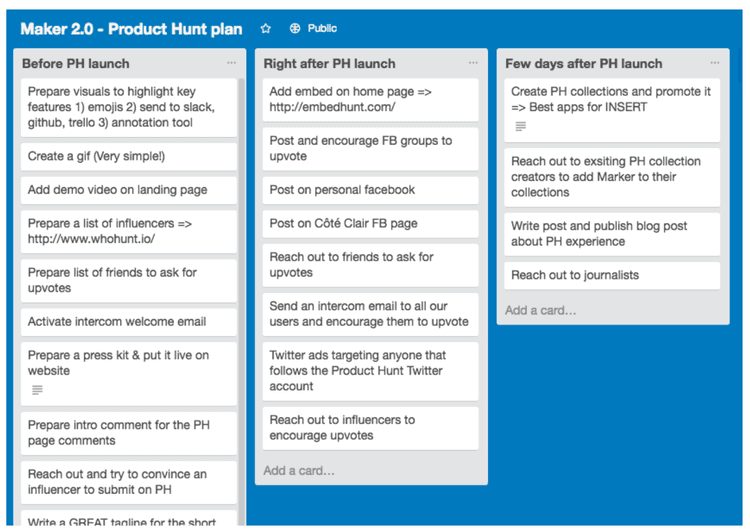
Leading up to your new product launch, focus on creating highly-shareable content like this to build awareness and stimulate conversation.
Launch day: Deploying your new product launch plan
Launch day is all about coordination. Without coordination, your chances of reaching the right audiences (and even virality) are lower.
Enable sales and marketing teams to spread the word about your new product, and have a clear plan for doing this.
Advocates and influencers should be prepared to push your message to their own audiences to further your impact.
All parties must understand how the product works, where it brings value to your audience, and why competitors’ customers should second-guess their choice. Luckily, you’ve covered this in pre-launch.
Here’s how to bring everything together on launch day.
10. Develop a coordinated plan of attack
Coordinate sales and marketing teams to have the right activities ready to go at the right time:
- Who is available to book product demo meetings?
- Will you be running live streams, webinars, giveaways, etc.? Who owns these tasks, and when and how will they take place?
- What emails will you send? How will they be scheduled? Who’ll be responsible for handling responses, and what kind of responses can you anticipate?
- If you have a sales team, who is making phone calls? To whom? When?
- Who is responsible for inbound calls?
Prepare your teams by having step-by-step plays ready to go (when X happens, we do Y). You won’t anticipate every customer challenge, but you can help your team operate autonomously by preparing as much as you can.
Leaders (particularly those with established audiences), should also be prepared to push the message out and engage with the community.
Let’s revisit Rand Fishkin.
On launch day, Fishkin engaged consistently with his Twitter audience, answering questions, demonstrating use cases, and helping the community get the most out of SparkToro.
Use your collaborative work platform to organize your plan so everyone knows where they’re meant to be and what they should be doing on launch day.
11. Share relevant content across your primary channels
Share a formal product announcement message along with other communications on launch day.
You’ve determined which channels you’ll rely most heavily on during the pre-launch phase; now’s the time to act on that plan:
- Roll out new product landing pages;
- Publish and share new blog posts and how-to articles;
- Schedule social media posts throughout the day that promote your product’s value props;
- Encourage discussions with your audience when they engage with your content;
- Coordinate media and PR releases to drop on the same day and link back to your main launch platform (such as the new product landing page).
The best way to communicate your new product launch is to show potential customers exactly how your product is going to solve their problem.
Take CRM platform monday.com.
When they released their new product workdocs (a collaborative document editor similar to Google Docs), monday.com used a short, informative video to demonstrate the product’s value and key competitive differentiators.
The video featured a face-to-face comparison with existing word document editors demonstrating workdocs’ speed and collaboration abilities, showing their audience exactly why they should choose workdocs over a competitor product.
12. Galvanize your advocates for sharing launch-day content
Leverage any influencers you have a relationship with—without “buying” them.
Ensure that your influencer partner sincerely backs what you’re selling and that it’s helpful to their audience.
Engage your advocates to upvote your new product on Product Hunt, and to share content on relevant social media platforms.
To maximize engagement (and to allow influencers to retain authenticity), have advocates publish unique content rather than simply retweeting your existing posts.
Take Ashley R. Cummings, freelance writer, and SparkToro advocate.
Rather than simply retweeting one of Fishkin’s product videos Cummings shares a quick tip on using SparkToro to find interview sources.
Fishkin then leverages this user-generated content by sharing this insight and product advocacy with his own audience.
13. Use a referral program to turn your customers into advocates
Referral schemes are an important part of long-term product marketing strategy, generating a near-passive stream for customer acquisition.
Take Airtable, a low-code platform for building collaborative apps.
Airtable encourages users to invite their network by offering $10 worth of credits for each person invited.
Use a compelling referral offer to grow your customer base quickly at launch.
For example, you could offer a “first month free” initiative for both the inviter and invitee. Offer this incentive for a limited time to boost initial launch sign-ups before reverting to your long-term referral scheme offer.
Post-launch: Conducting a post-mortem
Focus areas for the post-launch phase are retention of your new, hard-won customers, and KPI tracking. Consider:
- How do we retain the customers we’ve attracted at launch? How can we convert trial users into paid ones? What tactics do we have in play to upsell and increase customer lifetime value (CLV)?
- What KPIs are we tracking? How does our performance stack up against expectations? What are the underlying causes behind low performance (if applicable), and what will we do about it?
- What lessons can we learn from this experience to apply to future product launches? What insights have we gained that might apply to product development in the next life cycle?
The launch isn’t over at midnight on launch day. Here’s what to do next.
14. Execute your customer retention strategy
Your product launch tactics were successful. You’ve attracted a group of prospects and converted them into users.
Now it’s time to keep them from switching to the competition.
- Use customer-facing webinars to show existing customers how to get the most out of your product and to demonstrate specific applications.
- Leverage email marketing campaigns to introduce users to product features step-by-step.
- Send out product updates when resolving bugs or adding new features.
- Encourage customers to follow your social media pages, and post insightful, shareable guides to using your product in a real-life context.
Make your customer retention strategy a two-way conversation by encouraging customers to give feedback on your product. Ask those who switched from a competitor what drove them to leave.
Alex Turnbull of GrooveHQ shares a simple email template for capturing customer feedback.
Analyze customer service data and support logs to identify areas of friction. Review email performance to understand what actions take place (or don’t) when you send out retention-focused emails.
15. Conduct a post-mortem and analyze results
Start by evaluating your performance on metrics that measure the success of your product launch. Track metrics like:
- Content engagement metrics such as time on page, bounce rate, and page views;
- Click-through rates for ads and organic content;
- Volume-based KPIs like the number of new trials, new customers, referrals, sales qualified leads;
- Total revenue from customers acquired through online marketing;
- Cost Per Lead segmented by acquisition channel, and;
- Average Customer Value.
Compare your actual metrics against your forecasts and goals, and ask:
- Which goals did we achieve?
- Which goals did we not achieve?
- In either case, why?
Try not to make assumptions about the reasons behind meeting (or not meeting) your goals.
Engage with your customers (and non-customers) to understand how your marketing efforts impacted performance against benchmarks.
If you hit your goal for sales qualified leads, but fell short of the KPI for the number of new customers, this may indicate a breakdown somewhere in the sales process.
Analyze sales pipeline data to understand drop-off rates at each stage. Meet with sales reps to find out how customers respond to your messaging and word tracks. Set up interviews with missed opportunities, and ask them why they chose not to sign up.
16. Share key learnings with internal departments
Don’t make the mistake of keeping your post-mortem insights to yourself. Sales, marketing, product, and customer success teams can all learn from your findings. They may be able to provide additional insights into what worked and what didn’t.
Use these questions to deconstruct the results of your new product launch marketing plan, and share your answers with all relevant departments:
- What lessons can go toward the next product launch?
- What could sales have communicated better?
- What new issues are being presented to the support team?
- What assets could optimize your marketing campaigns?
- What demos could ease customers into the new product?
- What does our product usage data tell us about the usefulness of the new product?
Post-launch insights can also prove invaluable for informing the product roadmap, so make sure to share key learnings with the product team as well.
Take Wonderflow, a voice of customer analytics company.
Wonderflow was working with a client who produced an innovative new baby monitor. Unfortunately, the product launch didn’t go as planned, and the client wasn’t gaining a lot of traction.
The post-launch feedback analysis identified the problem: the monitor remained silent if there was nothing to report, but parents wanted a regular update, problem or not.
The product team used this feedback to change the monitor’s update sequence, the product marketing team adjusted their messaging and marketing collateral, and sales communicated the updated feature to prospects.
Conclusion
New product launches are a core aspect of product marketing. They require careful collaboration and coordination of sales, marketing, product, and customer success teams to execute effectively.
The majority of your new product launch plan activities take place pre-launch, but don’t discount the importance of a post-launch analysis of your new product’s impact, and subsequent changes to your product marketing strategy.
Master new product launch planning to start getting revenue out the gate with CXL’s Product Marketing Minidegree.



